[ad_1]
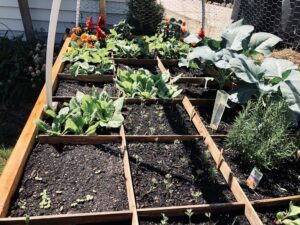
Crop rotation, or rising the identical vegetable in the identical location solely as soon as each three or 4 years, may also help cut back issues with pests and ailments.
When you’ve heard of this method however aren’t certain the right way to do it together with your raised beds, learn on for steering.
Why You Ought to Rotate Crops
One of many causes Sq. Foot Backyard beds are grown with polycultures (that’s to say, a mixture of differing kinds of greens) is to maintain vegetation more healthy. Rising a raised backyard field with a various array of members makes it tougher for each bugs and plant ailments to unfold from sq. to sq..
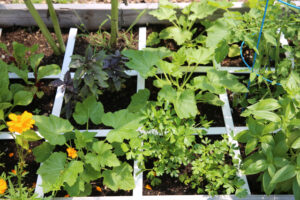
A various, polyculture mattress
Crop rotation ensures this variety within the backyard, however throughout area and time.
For example, should you had a flea beetle downside together with your kale this yr, rising extra kale in the identical spot subsequent yr can worsen the issue since flea beetles can overwinter within the soil.
As an alternative, re-plant with a completely completely different sort of vegetable that isn’t liable to flea beetles, and people little pests will transfer on or die out. Rising a various sequence of veggies will make issues much less inviting for these undesirable friends.
Take Notes on Your Plantings
Now that you just perceive the significance of transferring issues round in your beds, let’s deal with a sensible matter. If you wish to change out your backyard picks, it’s essential to know what you grew beforehand!
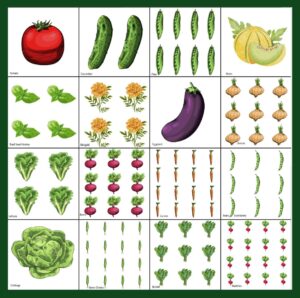
So, attempt protecting a pocket book with “maps” of your raised mattress – and don’t fear, your designs don’t need to be artworks. Sketch out a drawing of your field, divide it into sixteen equal squares, and label every sq. with what you’ve planted. Grid paper will make this job even simpler.
Alternatively, you would possibly need to use our plant spacing chart. It comes with a clean planning sheet that you should use to map out your individual Sq. Foot Backyard beds.
Obtain the plant spacing chart right here – it’s free!
Every time you sow or transplant a veggie into the field, make a remark. When a brand new yr of rising begins, make a brand new drawing and label it accordingly. This manner you’ll be able to look again at earlier years’ plantings and keep away from rising the identical crop or plant household within the sq. for the following two or three years.
Suppose in Plant Households
Now that you’ve got a manner of monitoring your raised mattress plantings, you’ll need to take a fast dip into “Botany 101” and study to acknowledge a couple of botanical households.
That’s as a result of members of the identical household are usually weak to the identical pests and ailments, so it’s not sufficient to alternate particular person veggies. We additionally must cycle crop households.
Listed below are a number of the commonest backyard veggie households and a few of their members:
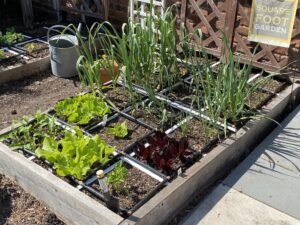
Having a number of beds makes alternating even simpler.
Allium household: Garlic, onions, leeks, chives, shallots.
Amaranth household: Amaranth, beets, spinach, Swiss chard.
Aster household: Lettuce, sunflowers.
Brassicas, or cruciferous household: Broccoli, cauliflower, radishes, cabbage, bok choy, kale, collards, brussels sprouts, mustard greens, arugula, kohlrabi, turnips.
Cucurbit household: Cucumbers, melons, pumpkins, squash, zucchini.
Legume household: Beans, cowpeas, chick peas, fava beans, peas.
Nightshade household: Tomatoes, peppers, eggplant, potatoes, tomatillos, floor cherries.
Parsley household: Carrots, parsnips, fennel, dill, cilantro, parsley.
Swap Crops at Every New Planting
Now that you’ve got a instrument for monitoring plantings and a solution to group veggies into households, it will likely be a lot simpler to alternate backyard produce in your containers: merely select completely different households for a given sq. for the following three to 4 years. Questioning how typically to swap crops? Achieve this every time you re-plant a grid sq. – meaning not less than yearly, and ideally each time you sow or transplant a succession of recent veggies.
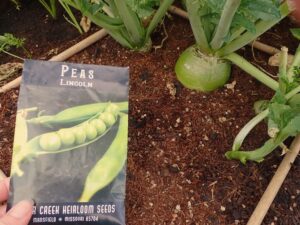
After harvesting radishes, I’m sowing peas subsequent. Photograph credit to Kristina.
When you’re re-sowing any grid sections in anticipation of fall, that is additionally the proper time to play one other spherical of musical chairs. Whereas alternating greens amongst squares is an effective place to begin, you may additionally need to cycle raised beds.
For example, if you’re rising a salsa backyard (with tomatoes, peppers, and tomatillos) in one among your containers this yr, think about using that very same mattress for a salad backyard (with lettuce, radishes, cauliflower, arugula, and peas) subsequent yr.
Now that you know the way and why to rotate the grids in your raised mattress, it ought to really feel as enjoyable as a sport!
Be taught extra in regards to the Sq. Foot Gardening Technique by taking the introductory course.
[ad_2]
Supply hyperlink